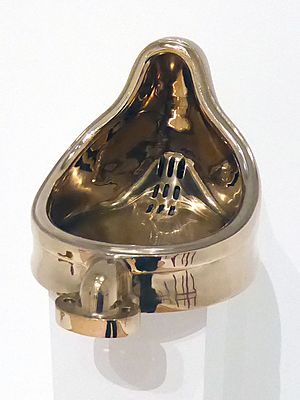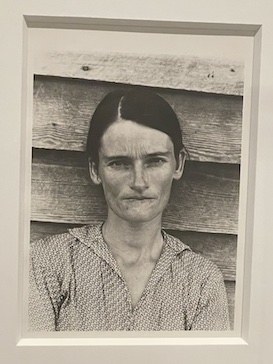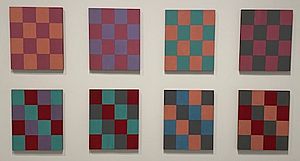Sherrie Levine facts for kids
Quick facts for kids
Sherrie Levine
|
|
|---|---|
| Born | 17 April 1947 |
| Education | University of Wisconsin in Madison |
| Known for | Rephotography, Painting, Sculpture, Conceptual art, Appropriation art |
Sherrie Levine (born 1947) is an American artist known for her work in photography, painting, and sculpture. She is a famous conceptual artist. This means the idea behind her art is often more important than the final object.
Much of her art involves creating exact copies of famous works by other artists. She has photographed pictures by photographers like Walker Evans, Eliot Porter, and Edward Weston and presented them as her own. This style of art is called appropriation art.
Contents
Early Life and Artistic Start
Sherrie Levine was born in Hazleton, Pennsylvania, in 1947. She spent most of her childhood in the suburbs of St. Louis, Missouri. Her interest in art began when she was eight years old. Her mother, who was a painter, would take her to the St. Louis Art Museum.
Her mother also took her to see artistic films, which later influenced her work. After high school, Levine studied at the University of Wisconsin in Madison. She earned a Bachelor of Arts degree in 1969 and a Master of Fine Arts degree in 1973. After doing different jobs in art and teaching, she moved to New York City in 1975 to focus on her career as an artist.
A Different Kind of Art
Levine's art often challenges our ideas about what is original. She takes well-known artworks from modern art history and remakes them. By doing this, she asks important questions about who gets to be a famous artist and what makes art valuable.
Appropriation art, the style Levine is known for, became popular in the late 1970s and 1980s. It involves using or copying existing images or objects with little or no change. Levine believed that by copying famous art, she was showing how images in our culture are often repeated, just like pictures of celebrities.
Copying Famous Art to Ask Big Questions

Levine's work is a form of commentary. She often chose to copy works made by famous male artists. She said this was a way to challenge the fact that art history has been dominated by men.
After Walker Evans

Levine is most famous for her 1981 series of photographs called After Walker Evans. For this project, she took photographs of pictures from a book of Walker Evans's work. Evans's original photos showed the lives of poor families in the American countryside during the Great Depression. They are considered very important historical photographs.
Levine didn't change the images at all. She simply photographed the photos and presented them as her own work. This caused a lot of debate. The people who owned the rights to Walker Evans's photos said it was a copyright violation. They took Levine's works to stop her from selling them. Later, Levine gave the entire series to the Walker Evans Estate. Today, the Metropolitan Museum of Art in New York owns the series.
By copying these famous images, Levine made people think about authorship. Who is the real author of a picture? Is it the person who first clicked the camera, or can someone else give it new meaning?
Other Famous Copies
Levine has used this method with many other artworks.
- Fountain (After Marcel Duchamp): In 1991, she created a sculpture called Fountain. It was a bronze urinal modeled after a famous 1917 artwork by Marcel Duchamp. Duchamp's original was a regular urinal he called art. Levine's version was cast in polished bronze, making it look like a classical sculpture. This highlighted the questions of what is a copy and what is an original.
- The Bachelors (After Marcel Duchamp): In 1989, she created a series of six glass sculptures. They were based on shapes from another of Duchamp's famous works. By displaying them in separate glass cases, she changed the meaning of the original piece.
- Paintings and Sculptures: She has also made watercolor paintings based on the work of Fernand Léger and created glass copies of sculptures by Constantin Brâncuși.
Art with a Feminist Message

Levine's work is often seen as feminist. Feminism is the belief in social, economic, and political equality of the sexes. In the art world, feminist artists often point out how men and their perspectives have been dominant for centuries.
By copying the work of famous male artists, Levine was making a powerful statement. She was inserting herself, a woman, into an art history that had often left women out. She once said that "the art world is so much an arena for the celebration of male desire." Her work tries to question and change that.
Exhibitions and Collections
Sherrie Levine's art has been shown in major museums all over the world. In 2011, the Whitney Museum of American Art in New York held a large exhibition of her work called Mayhem. This show covered her entire career, from her famous photographs to newer sculptures.
Her work is part of the permanent collections of many famous museums, including:
- The Broad, Los Angeles
- Centre Georges Pompidou, Paris
- Institute of Contemporary Art, Boston
- Museum of Modern Art, New York
- Solomon R. Guggenheim Museum, New York
- Tate Gallery, London
- Whitney Museum of American Art, New York
See also
 In Spanish: Sherrie Levine para niños
In Spanish: Sherrie Levine para niños
- Appropriation art
- Neo-conceptual art
- The Pictures Generation

